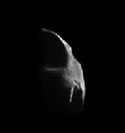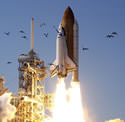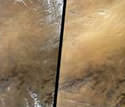After three weeks of tests, NASA controllers have given the newly upgraded Hubble Space Telescope a clean bill of health. Initial tests are largely complete; however, calibrations of the observatory’s instruments are expected to continue for another two months. Routine science observations have now resumed using the telescope’s Imaging Spectrograph and the Wide Field and Planetary Camera 2.
After three weeks of in-orbit checkout, following its deployment from Space Shuttle Columbia on March 9, the Hubble Space Telescope has been declared healthy and fit by engineers and scientists at NASA’s Goddard Space Flight Center in Greenbelt, Md., and the Space Telescope Science Institute in Baltimore.
Initial checkout of the spacecraft and instruments has largely been completed. However, the calibration process for the instruments will continue for another two months. The new rigid solar arrays, coupled with the new Power Control Unit, are working perfectly, generating 27 percent more electrical power than the old arrays. This increase in power roughly doubles the power available to the scientific instruments. The new reaction wheel is operating normally.
The powerful new Advanced Camera for Surveys (ACS) is now undergoing its final optical alignment and focus checks. The image quality of individual stars observed in a standard calibration field is excellent. The Advanced Camera’s light-sensing detectors are also working very well. It is anticipated that the first Early Release Observations of astronomical targets taken with the Advanced Camera for Surveys will be available around the first week in May.
The new, high-tech mechanical cooler inserted by the Astronauts during SM3B has been working continuously and properly since March 18. The cooler?s intended purpose is to attempt to resuscitate the dormant Near-Infrared Camera and Multi-Object Spectrometer (NICMOS), which depleted its expendable solid nitrogen coolant in January 1999. Although this new ?refrigerator?, dubbed the NICMOS Cooling System (NCS), has been reliably generating the amount of cooling power expected, Hubble engineers report that the NICMOS instrument is cooling down more slowly than originally expected. Because it will take longer to reach the proper operating temperature, below approximately 80 degrees Kelvin, the initial checkout and scientific observations with NICMOS will be delayed for several weeks.
Routine science observations have now resumed with the Space Telescope Imaging Spectrograph and the Wide Field and Planetary Camera 2, the two instruments that were operating on Hubble prior to Servicing Mission 3B. On another note, a gyro (Gyro 3) that had not been performing as well as it should prior to the mission resumed perfect operation after it was turned off and re-started while Hubble was in Columbia’s payload bay.
The Space Shuttle Columbia journeyed to the Hubble Space Telescope for the fourth servicing mission on March 1, 2002. During a series of five spacewalks, Astronauts installed new hardware and upgraded older systems, leaving the telescope better than ever. After a successful mission spanning 11 days in orbit, the shuttle landed safely on March 12 at Kennedy Space Center, Fla.
Original Source: NASA News Release



